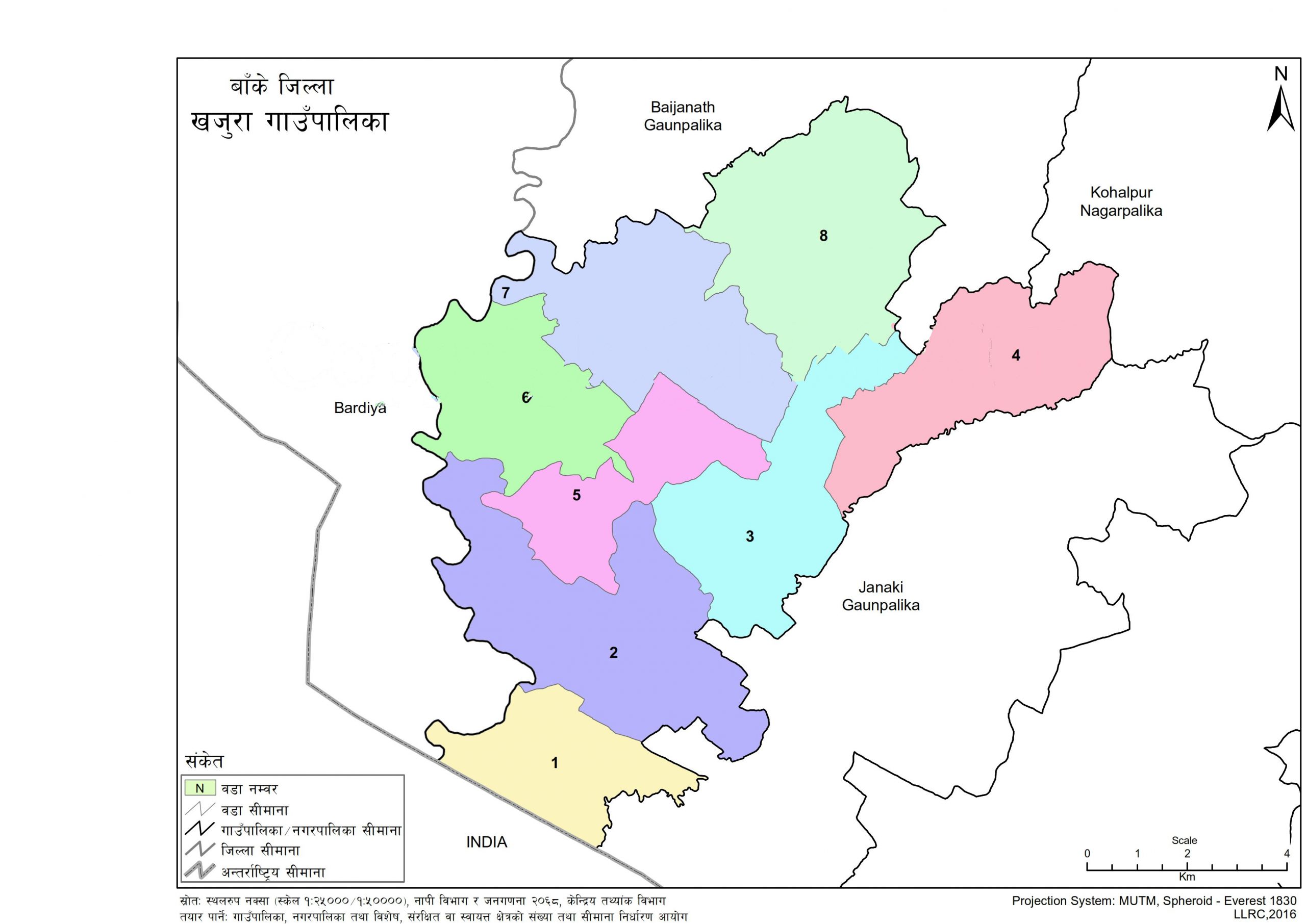
Wardwise Population and Households
As per 2011 population census, Khajura Rural Municipality had total 50,961 population with 23,504 males and 27,457 females. Out of total wards, ward number 2 had the largest population 8,626, while ward number 1 had least number of population with 8,626.
With respect to number of households, Khajura Rural Municipality had total 10,288 households. The ward number 2 had most households with total 2,003, while ward number 1 had least number of households with total 756 number of households.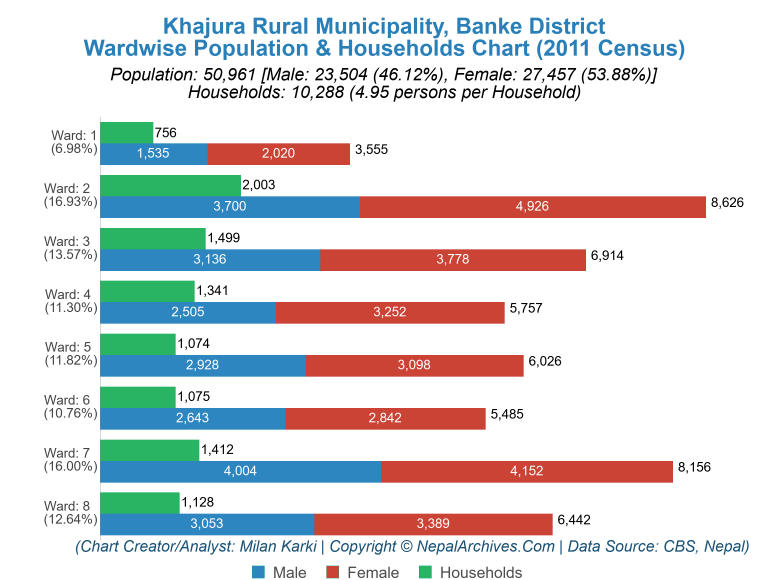
As illustrated in the chart, the ratio of male to female population was 0.86, which indicates that Khajura Rural Municipality had 14 percent lower males as compared to the females. Same as, the population to household ratio was 4.95, which means that in average 4.95 family members lived in each household.
Absentee Population
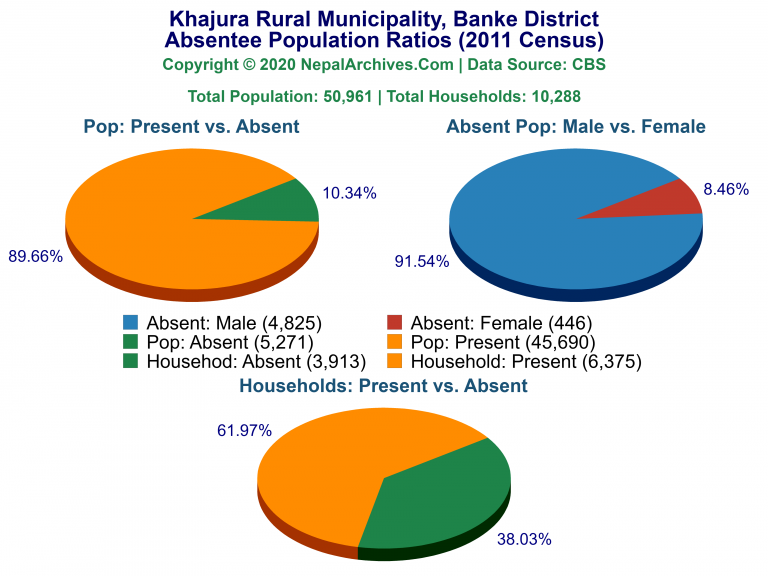
As illustrated in the charts, the ratio of absentee population was 8.67, while male to female absentee population ratio was 10.82. Same as, the household ratio of present vs. absent population was 1.63.
Population by Age Group
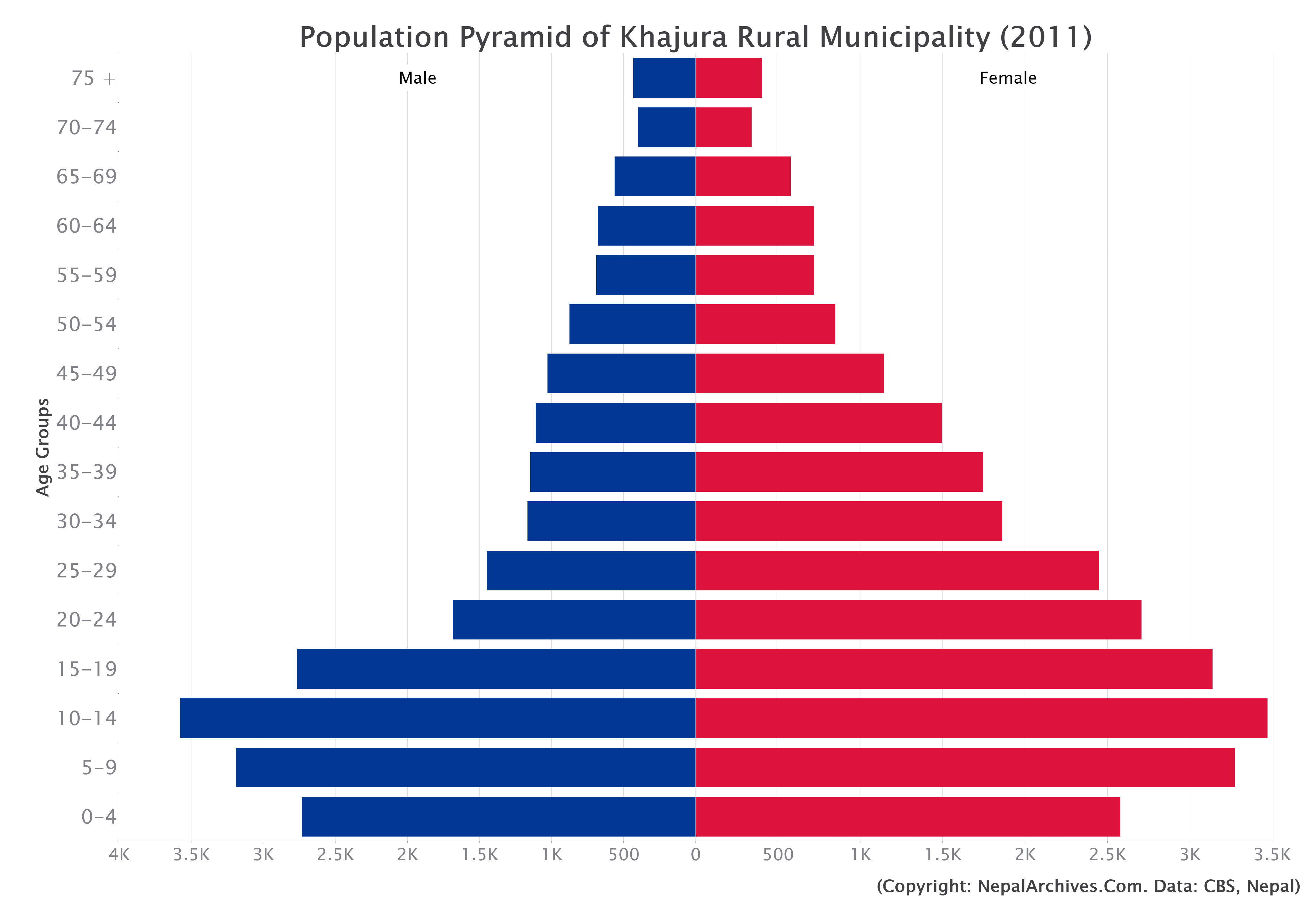
Gender wise, top 5 most age groups male population were between 10 and 14 (3,578), between 5 and 9 (3,191), between 15 and 19 (2,766), below 4 (2,733), and between 20 and 24 (1,686), with total population of 13,954. In contrast, bottom 5 least age group male population were between 70 and 74 (401), above 75 (434), between 65 and 69 (563),between 60 and 64 (680), and between 55 and 59 (690), with total population of 2,768. With regards to female population, top 5 age groups females were between 10 and 14 (3,471), between 5 and 9 (3,273), between 15 and 19 (3,138), between 20 and 24 (2,706), and below 4 (2,578), with total population of 15,166. In contrast, bottom 5 least age group male population were between 70 and 74 (339), above 75 (402), between 65 and 69 (577),between 60 and 64 (717), and between 55 and 59 (718), with total population of 2,753.
The population with age-group 70 to 74 had male to female ratio of 1.18, which states that this age group had maximum males as compared to females. Similarly, age-group 25 to 29 had most female population as compared to male population with male to female ratio of 0.59. The age-groups 70 to 74, above 75, below 4, 10 to 14, 50 to 54 had majority of male population while age-groups 65 to 69, 5 to 9, 55 to 59, 60 to 64, 45 to 49, 15 to 19, 40 to 44, 35 to 39, 30 to 34, 20 to 24, 25 to 29 had majority of female population as per male-female ratios. Moreover, age-groups had eqivalent or almost equal numbers of male and female population with male-female ratios of 1.
The population pyramid for Khajura Rural Municipality visually illustrates the male vs. female population based on different age groups. The population data and ratio tables are also available in this link.
Population Ratios
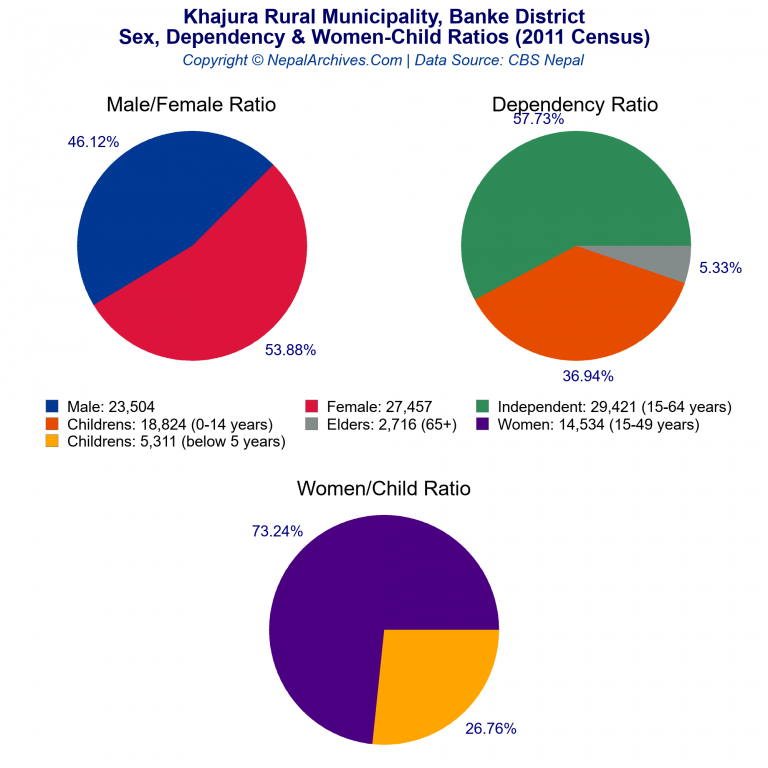
There were 57.73 % (29,421 ) of independent population, the working age people between ages of 15 and 64 years. The dependent children, ages below 15 years, were 36.94 % with total number of 18,824. The dependent elderly population, aged 65 and above were 5.33 % with total number of 2,716. As such, total dependent population including children and elderly people were 42.27 with total number of 21,540
There were 14,534 women of child-bearing age-group of 15 to 49 years. Same as, the todlers or children of 4 years or below were 5,311. The ratio of woman of child-bearing age and the number of todlers state that, approximately 365 children were born per 1,000 women. This number is also roughly used as fertility levels when direct measures of births are not available.
Literacy, Education Levels & Schooling
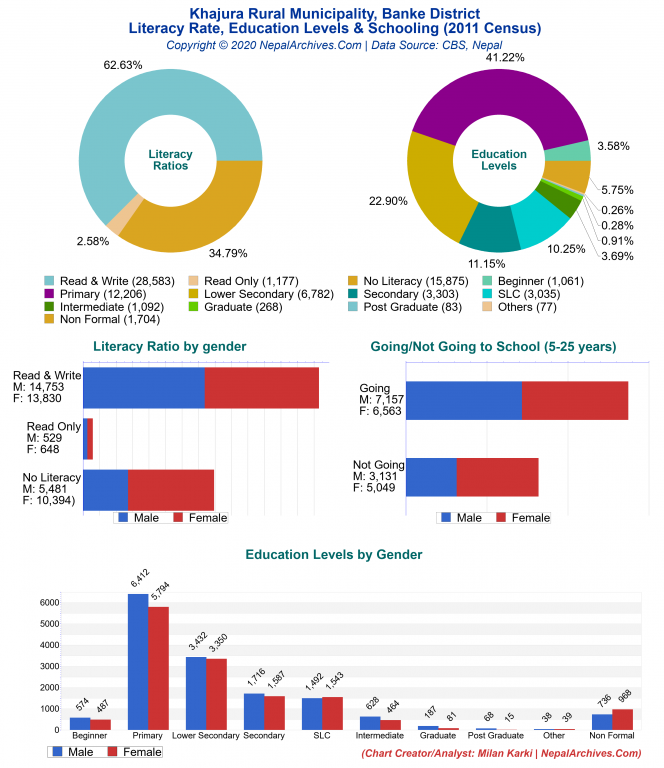
Grade 1-12 Students & Schools
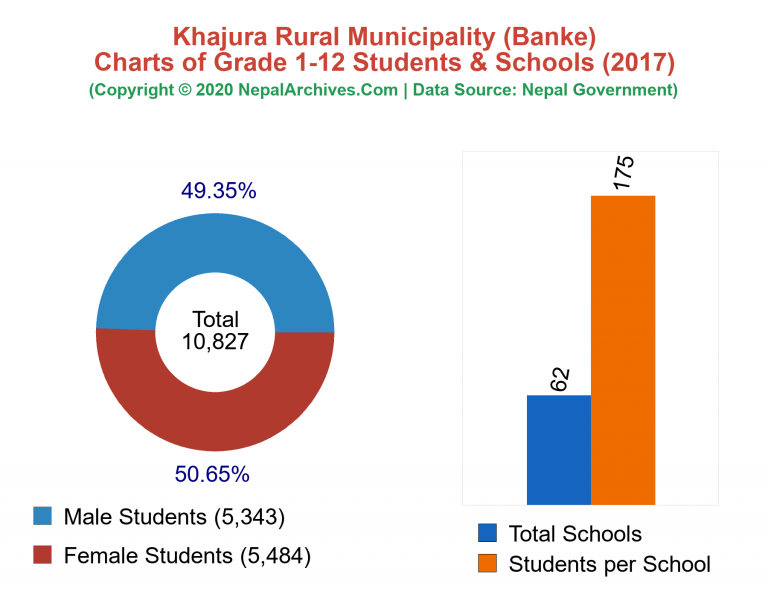
The pie-chart and graphs above further illustrates the students and schools.
Population by Language Spoken
Mostly spoken language in Khajura is Nepali, which is spoken by 28,108 people. The Khajura has people who speak other languages, such as Urdu, Avadhi, Tharu, Magar, Newar, Maithili, Gurung, Bhojpuri, Hindi, Tamang, Doteli, Chepang, etc.
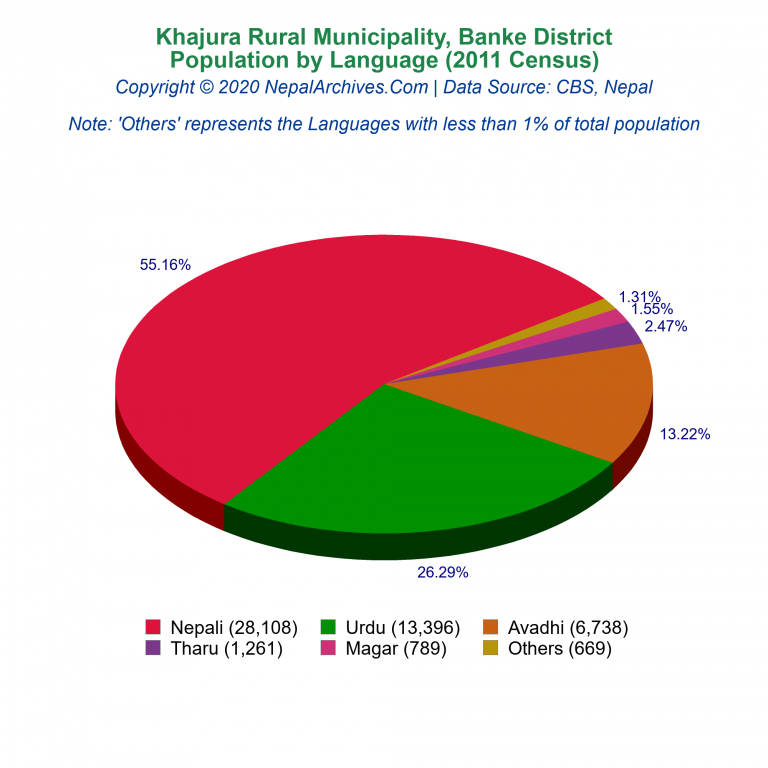 Out of total population, 15,759 female speaks Nepali language, while 12,349 male speaks Nepali language.Details information about languages spoken by male and female groups of population has been illustrated in the table.
Out of total population, 15,759 female speaks Nepali language, while 12,349 male speaks Nepali language.Details information about languages spoken by male and female groups of population has been illustrated in the table.Population by Castes
According to 2011 census conducted by Central Bureau of Statistics (CBS), Khajura Rural Municipality was inhabitted by mostly the people of Muslim caste with total population of 13,621. There were as little as Gaderi/Bhedhar caste with population of as little as 15 in total. People of several other castes who live in Khajura are Chhetri, Magar, Kami, Brahmin - Hill, Yadav, Thakuri, Tharu, Gurung, Sanyasi/Dashnami, Damai/Dholi, Chamar/Harijan/Ram, Dhobi, Kurmi, Dusadh/Pasawan/Pasi, Sarki, Newar, Dalit Others, Kori, Badhaee, Kathbaniyan, Kanu, Tamang, Hajam/Thakur, Kayastha, Kumal, Haluwai, Teli, Kumhar, Terai Others, Lohar, Brahmin - Tarai, Chepang/Praja, Bangali, Natuwa, Koiri/Kushwaha, Badi, Majhi, Kalwar, Gaine, Rai, Kahar, Darai, Chamling, Gaderi/Bhedhar, Gharti/Bhujel, etc. Only the population of castes with above 1,000 population are illustrated in the table.
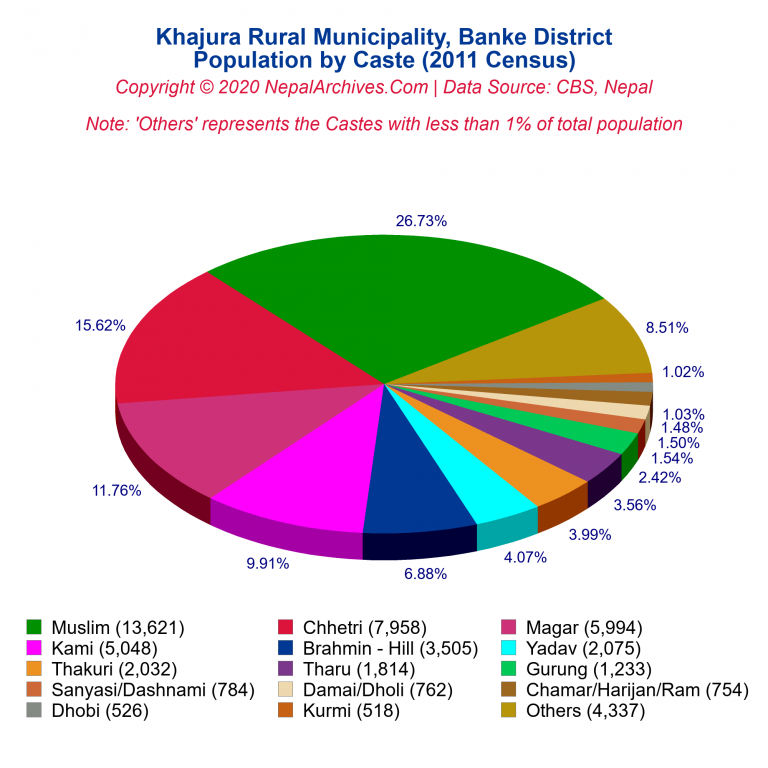 Top five castes of people in Khajura Rural Municipality are Muslim (13,621), Chhetri (7,958), Magar (5,994), Kami (5,048) and Brahmin - Hill (3,505) with total population of 36,126, which forms 70.89 percent out of total population of 50,961 in Khajura Rural Municipality.
Top five castes of people in Khajura Rural Municipality are Muslim (13,621), Chhetri (7,958), Magar (5,994), Kami (5,048) and Brahmin - Hill (3,505) with total population of 36,126, which forms 70.89 percent out of total population of 50,961 in Khajura Rural Municipality.Population by Disability
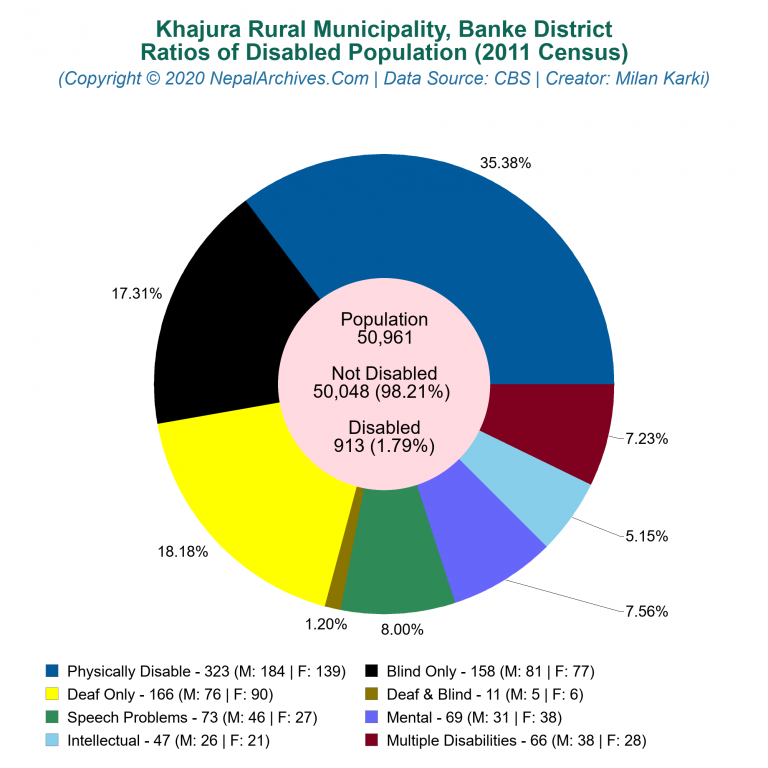
Similarly, there were 158 people who were blind and 166 people were deaf, while 11 people were both blind and deaf. Moreover, 73 persons had reported of having speech problems. Total 66 people had multiple disabilities.
The pie-chart above illustrate the better picture of disabled population along with genderwise ratios.
Household Foundation
With respect to wall of the houses, 3,682 houses were mud bonded, 1,958 houses were cement bonded, 210 houses were wood planks bonded, 113 houses were bamboo bonded and 592 houses had unbaked bricks on their outer walls.Rest of the houses were reported of having other types of outer wall, while some of them reported nothing of having the outer wall bonding.
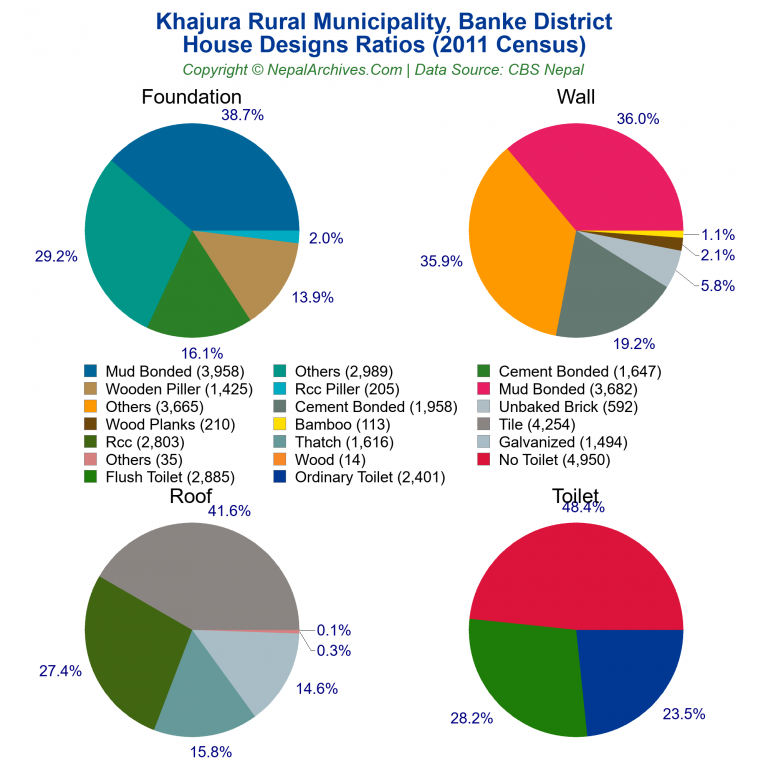
There were several types of house roofs reported. Total 1,616 houses were reported of having thatch roofs while 1,494 houses had galvanized roofs. Similarly, 4,254 houses had roof of tile, 2,803 houses had RCC roofs, 14 houses had roof of woods while 0 houses were reported having roof of mud. As per 2011 CBS census, some of the houses had other types of roofs while some didn't report about the roof structure.
With respect to the toilets, 4,950 out of 10,288 houses didn't report of having a private toilet for their households. Nevertheless, 2,885 houses were reported of having flush toilet while 2,401 houses reported having ordinary toilets.
Utilities
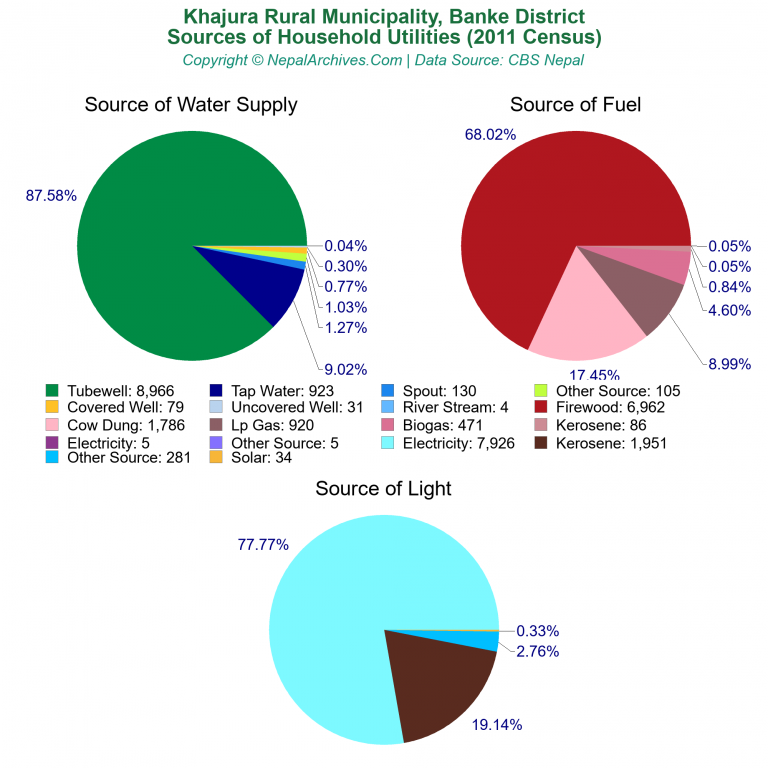
With reference to source of fuel, 6,962 households reported their source of fuel as firewood while 86 households had kerosene as their fuel source. The LP gas was used by 920 households as a source of fuel. Moreover, other sources of fuel were cow dung (1,786), bio-gas (471), fuel electricity (5), etc.
Same as, total 7,926 households had reported of having electricity as the source of their household's lighting. The households still using kerosene as source of light were 1,951, while 34 households used solar energy as source of lights. Total 0 households also reported of using bio-gas as a source of light. The ratio of use of electricity as compared to other source of light was 0.77.
Facilities
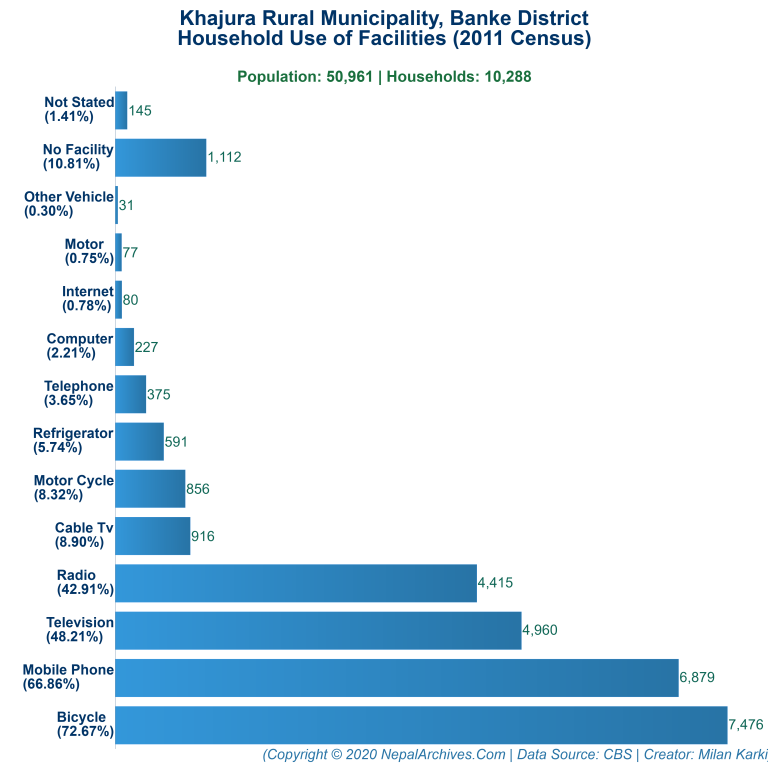
Economic Census
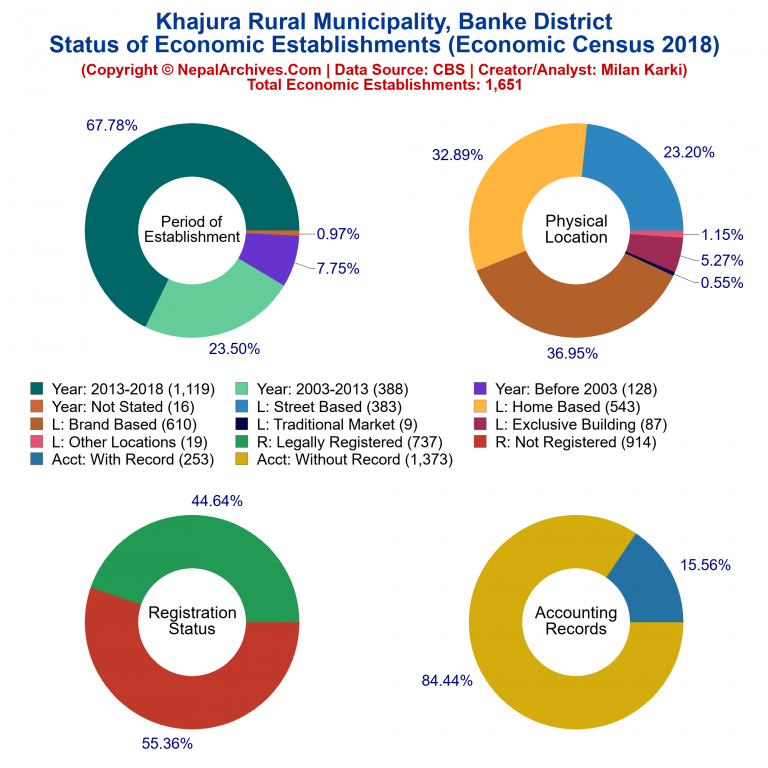 According to 2018 Economic Census, there are total 1,651 establishments in Khajura Rural Municipality that are involved in various economic activities. In those establishments, total 4,478 persons are engaged for the economic activities, as a self-employed or an employee, with total male engagement of 2,775 and female engagement of 1,703 persons.In every business, there were an average of 2.71 people engaged with average males are 1.68 and females are 1.03. The ratio of male to female engagement in the establishments are 1.63, which means as many as 1.63 males are enagement in the economic activities per female.
According to 2018 Economic Census, there are total 1,651 establishments in Khajura Rural Municipality that are involved in various economic activities. In those establishments, total 4,478 persons are engaged for the economic activities, as a self-employed or an employee, with total male engagement of 2,775 and female engagement of 1,703 persons.In every business, there were an average of 2.71 people engaged with average males are 1.68 and females are 1.03. The ratio of male to female engagement in the establishments are 1.63, which means as many as 1.63 males are enagement in the economic activities per female.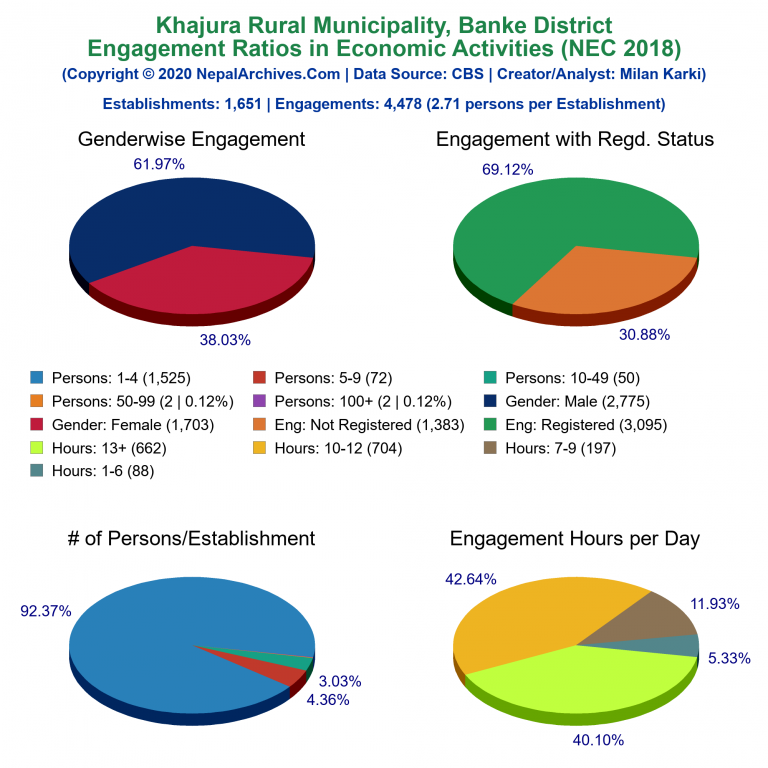 Similarly, the engagement of males were 61.97 percent while the females are 38.03 percent.
Similarly, the engagement of males were 61.97 percent while the females are 38.03 percent.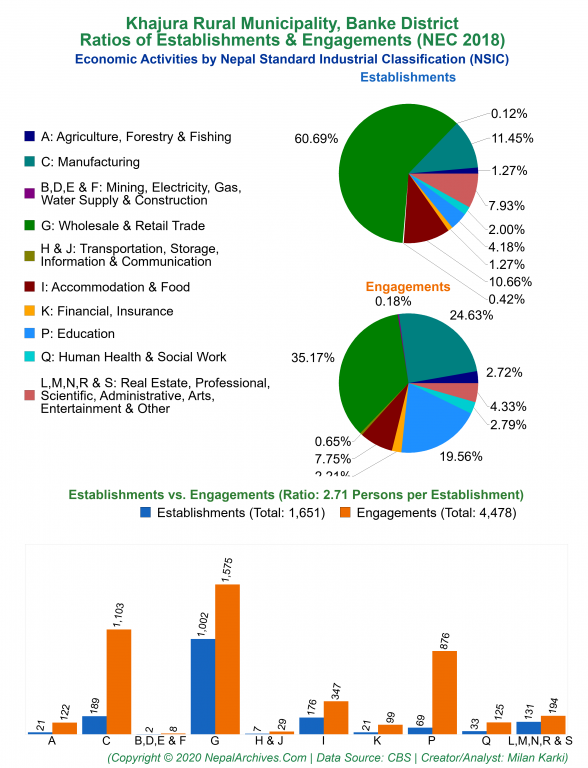
(Desclaimer: The statistical data published about Khajura Rural Municipality profile in this page are exclusively obtained from Nepal Government's Central Bureau of Statistics (CBS) as well as other verifiable Nepal Government sources. The profile of Khajura Rural Municipality has been published for information and research only, which can be relied based on its primary source. Nevertheless, NepalArchives.Com does not provide any guaranty of the validity of the stastical information in this page. Any question about the statistical validity of information should be directed to Nepal Government Agency. However, if you found any error or inconsistency of information in this page, please kindly let us know so that we will improve this page. Thank you.)
